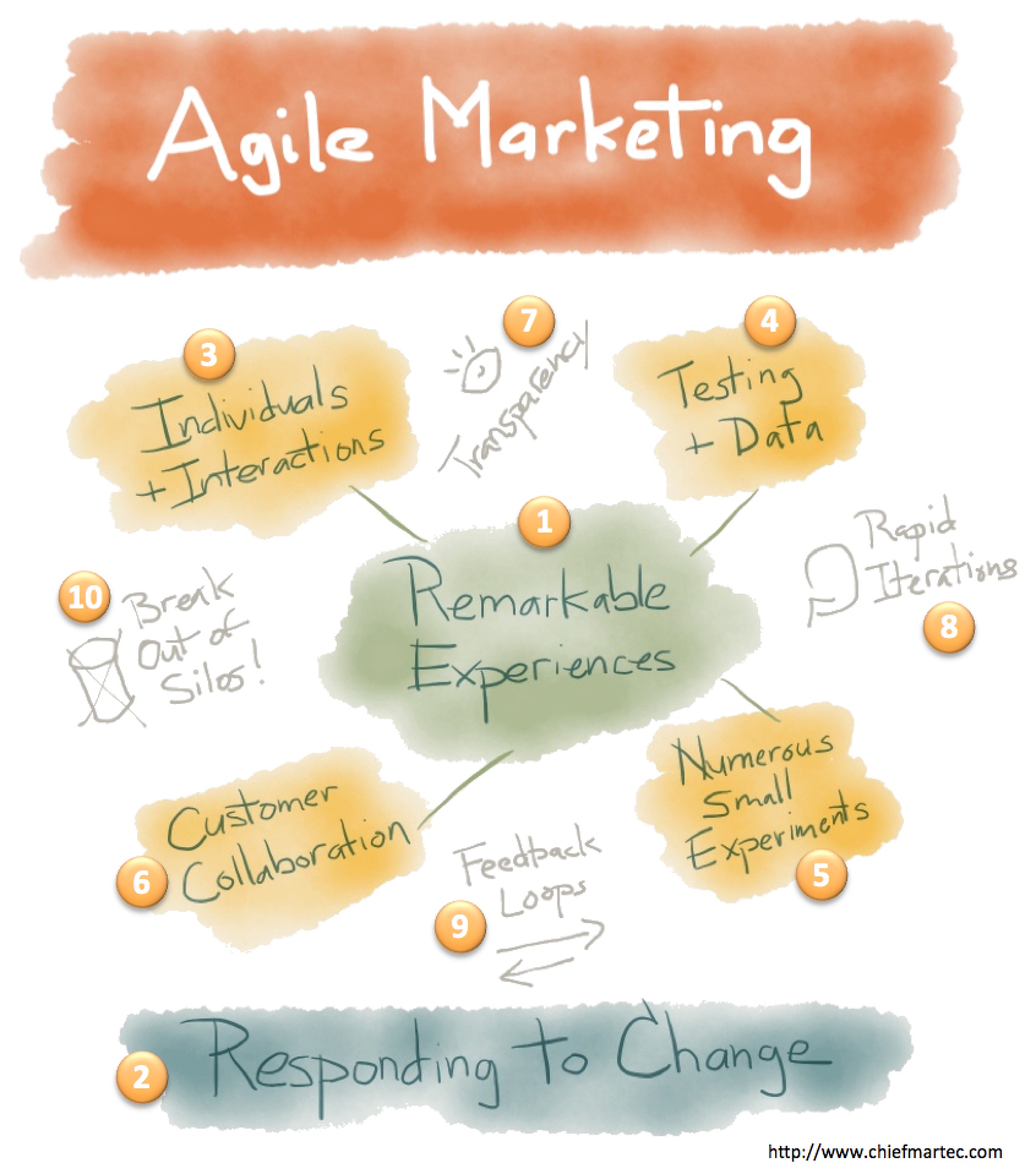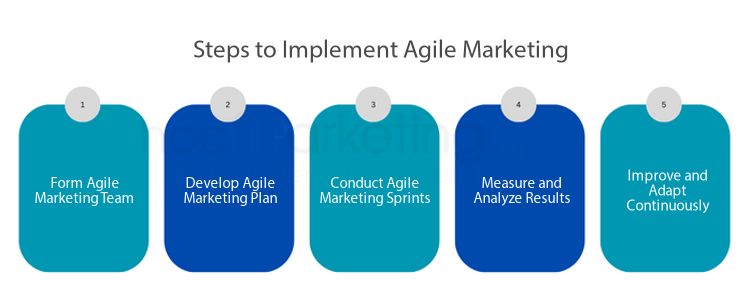
What is Agile Marketing? Pros and Cons? Steps to Implement Agile Marketing

Discover the power of Agile Marketing with this comprehensive guide. Learn the pros and cons, steps to implement, and case studies of successful implementations. Form a team, develop a plan, conduct sprints, measure results, and continuously improve to achieve marketing success.
Welcome to our latest blog post, where we delve into the world of Agile Marketing. In today's fast-paced digital landscape, traditional marketing methods are no longer enough to keep up with the competition. Agile Marketing, on the other hand, is a modern approach that allows businesses to quickly adapt to changes and respond to customer needs in real-time. In this post, we will define Agile Marketing, explore its principles, discuss its pros and cons, and provide a step-by-step guide on how to implement it successfully. We will also take a look at some case studies of companies that have leveraged Agile Marketing to achieve impressive results. So, let's get started and discover how Agile Marketing can help your business stay ahead of the game.
What is Agile Marketing?
Agile marketing is a relatively new approach to marketing that has been gaining popularity in recent years. It is a methodology that takes inspiration from agile software development and applies it to the world of marketing. Essentially, agile marketing is a way of working that is characterized by flexibility, adaptability, and collaboration. It is designed to help marketing teams respond quickly to changes in the market, customer feedback, and emerging trends. In this section, we will explore the definition and principles of agile marketing, which will help us to understand the methodology in more detail.
Agile Marketing Definition
Agile Marketing is a marketing approach that emphasizes flexibility, adaptability, and responsiveness to changing market conditions and customer needs. It is inspired by the Agile software development methodology, which has been widely adopted in software development teams to increase their efficiency and productivity. In Agile Marketing, teams work in short, iterative sprints to develop and execute marketing campaigns, allowing them to quickly test and refine their strategies based on real-time feedback from customers and stakeholders. The goal of Agile Marketing is to deliver value to customers faster and more effectively than traditional marketing approaches, while also fostering a culture of innovation, collaboration, and continuous improvement within marketing teams.
Agile Marketing Principles
Agile Marketing is based on principles that are aimed at improving collaboration, communication, and flexibility within marketing teams. These principles are adapted from the Agile software development methodology and include:
- Responding to change over following a plan: Agile Marketing emphasizes the importance of being able to quickly adapt to changes in the market, customer needs, or business priorities rather than sticking to a rigid plan.
- Working collaboratively with customers: Agile Marketing involves working closely with customers to understand their needs and preferences and creating campaigns that resonate with them.
- Embracing experimentation: Agile Marketing encourages marketers to experiment with different strategies, tactics, and channels to find what works best for their target audience.
- Measuring progress through data: Agile Marketing relies on data to measure the success of campaigns and inform decisions for future iterations.
- Prioritizing tasks based on value: Agile Marketing prioritizes tasks based on the highest value they provide to the business and customers.
These principles guide the Agile Marketing approach to help marketing teams become more responsive, adaptable, and customer-focused.
Pros and Cons of Agile Marketing
Agile marketing has both pros and cons that companies should consider before implementing it. On one hand, the flexibility and adaptability of agile marketing can bring significant benefits to companies. Agile marketing allows companies to respond quickly to changes in the market or customer needs, which can improve customer satisfaction and increase revenue. Additionally, agile marketing can help companies to prioritize and focus their resources on the most important tasks, which can lead to greater efficiency and productivity.
However, agile marketing also has its drawbacks. One of the biggest cons of agile marketing is the potential for increased complexity. Agile marketing requires cross-functional teams to work together closely, which can be difficult to manage and coordinate. Additionally, agile marketing can require significant changes to a company's culture and processes, which can be disruptive and time-consuming.
Another potential disadvantage of agile marketing is the risk of overcommitment. Agile marketing relies on the concept of sprints, which are short periods of time during which teams work on specific tasks. However, if teams commit to too many tasks during a sprint, they may become overwhelmed and unable to complete their work on time. This can lead to decreased productivity and morale.
Overall, companies should carefully consider the pros and cons of agile marketing before implementing it. While the benefits of agility and flexibility can be significant, the potential drawbacks of increased complexity and overcommitment should not be ignored. By carefully planning and executing an agile marketing strategy, companies can reap the benefits of this approach while minimizing the risks.
Pros of Agile Marketing
Agile marketing has become increasingly popular among marketers due to its numerous benefits. One of the main advantages of agile marketing is its flexibility. Agile marketing allows teams to quickly adapt to changes in the market, customer preferences, and emerging trends. As a result, companies can respond more rapidly to customer needs, making them more competitive in the market.
Another advantage of agile marketing is that it promotes collaboration and teamwork. By forming cross-functional teams, companies can bring together individuals with different skills and expertise to work together towards a common goal. This can lead to better decision-making, increased creativity, and faster problem-solving.
Agile marketing also helps to reduce the risk of failure. By breaking down large projects into smaller, manageable tasks, teams can test and refine their strategies before committing significant resources. This approach allows companies to identify potential issues early on and adjust their strategies accordingly.
Finally, agile marketing fosters a culture of continuous improvement. By regularly measuring and analyzing results, teams can identify areas for improvement and make changes to their strategies. This leads to more effective marketing campaigns, higher return on investment, and ultimately, increased revenue.
Overall, the benefits of agile marketing make it a compelling approach for companies looking to stay competitive in today’s fast-paced business environment.
Cons of Agile Marketing
Agile Marketing, while being a highly efficient and effective approach for modern marketing, it has some downsides that need to be considered. One of the main disadvantages of Agile Marketing is that it may require a significant shift in mindset and work culture. The approach requires team members to be flexible, open to change, and ready to work collaboratively. This can be challenging for organizations that have a hierarchical and rigid work structure or a culture that is resistant to change.
Another potential drawback of Agile Marketing is that it may not be suitable for all types of marketing projects. Agile Marketing is most effective when there is a need for quick decision-making, rapid project completion, and frequent iterations. However, some marketing initiatives, such as long-term branding campaigns, may not be suitable for Agile Marketing as they require a more strategic and long-term approach.
Furthermore, Agile Marketing may also require a higher level of coordination and communication among team members. The approach relies heavily on regular meetings, feedback sessions, and collaboration among team members. Without proper communication and coordination, the Agile Marketing approach may not be effective, leading to delays, missed deadlines, and incomplete projects.
In addition, Agile Marketing may also require a higher level of investment in terms of resources and tools. The approach requires a robust project management system, regular training for team members, and frequent updates to keep up with the latest trends and technologies. These investments may not be feasible for small organizations or those with limited resources.
Finally, Agile Marketing may also have some inherent risks associated with it, such as the potential for scope creep or project failure. Without proper planning and control, Agile Marketing projects may end up exceeding their scope or budget, leading to project failure.
In conclusion, while Agile Marketing offers many benefits, such as increased efficiency, faster project completion, and better collaboration, it also has some potential drawbacks that need to be considered. Organizations must carefully evaluate their needs, resources, and work culture before adopting Agile Marketing as an approach.
Steps to Implement Agile Marketing
To successfully implement agile marketing, there are five key steps that need to be followed. The first step is to form an agile marketing team. This team should consist of individuals from different departments who are able to work collaboratively towards achieving the same goals. The team should be cross-functional and consist of members who are able to offer different perspectives and skillsets.
The second step is to develop an agile marketing plan. This plan should outline the goals and objectives of the team, as well as the strategies and tactics that will be used to achieve them. The plan should also include a timeline for execution and a system for measuring and analyzing results.
The third step is to conduct agile marketing sprints. These sprints are short, focused periods of work that typically last between one and four weeks. During each sprint, the team will work towards achieving specific goals and objectives. At the end of each sprint, the team will review their progress and make any necessary adjustments to their plan.
The fourth step is to measure and analyze results. This involves tracking key metrics to determine the effectiveness of the team's strategies and tactics. Based on this analysis, the team can make data-driven decisions about which tactics to continue using, which to modify, and which to discard.
The final step is to continuously improve and adapt. Agile marketing is an iterative process, which means that the team should be constantly looking for ways to improve their strategies and tactics based on the results they achieve. This involves regularly reviewing and adjusting the agile marketing plan, as well as experimenting with new ideas and approaches.
By following these five steps, organizations can successfully implement agile marketing and achieve their marketing goals more efficiently and effectively.
Step 1: Form an Agile Marketing Team
Forming an Agile Marketing Team is the first step towards implementing Agile Marketing. This team is responsible for driving the entire process from planning to execution to analysis and improvement. It is important to form a team that is cross-functional, comprising members from different departments such as marketing, sales, product development, and customer service. This ensures that the team has a diverse set of skills and expertise to tackle different challenges that may arise during the process.
The team should also consist of individuals who are open to change, are willing to experiment, and are comfortable with the idea of failing fast and learning quickly. Agile Marketing is all about being flexible and adaptable, and the team should be able to embrace this mindset.
The team should have a clear leader who is responsible for guiding them through the process and ensuring that everyone is aligned with the goals and objectives of the project. The leader should also have a good understanding of Agile Marketing principles and methodologies, so that they can ensure that the team is following the right approach.
Once the team is formed, it is important to establish clear roles and responsibilities for each member. This ensures that everyone knows what they are accountable for and can work together efficiently. The team should also establish clear communication channels and processes, so that everyone is on the same page and can collaborate effectively.
Overall, forming an Agile Marketing Team is a crucial first step towards implementing Agile Marketing. The team should be cross-functional, open to change, and have a clear leader who can guide them through the process. Establishing clear roles and responsibilities, communication channels, and processes are also important to ensure that the team can work together effectively.
Step 2: Develop an Agile Marketing Plan
Developing an Agile Marketing Plan is the second step in implementing Agile Marketing. This step involves creating a roadmap that outlines the marketing goals, objectives, and strategies to achieve them. It requires collaboration between the Agile Marketing Team, stakeholders, and other relevant departments to ensure that the marketing plan aligns with the business objectives. The Agile Marketing Plan should be flexible and adaptable, allowing for changes and adjustments throughout the Agile Marketing process.
The first step in developing an Agile Marketing Plan is to identify the buyer personas and target audience. This involves understanding the needs, preferences, and behaviors of the target audience to create relevant and targeted marketing messages. The Agile Marketing Team can use customer data, feedback, and insights to create buyer personas and identify the target audience.
The second step is to define the marketing goals and objectives. The Agile Marketing Plan should have clear and measurable goals that align with the business objectives. The goals should be specific, measurable, achievable, relevant, and time-bound (SMART).
The third step is to create marketing strategies and tactics. This involves identifying the channels, content, and messaging that will be used to reach the target audience and achieve the marketing goals. The Agile Marketing Team should prioritize the strategies and tactics based on their impact, ease of implementation, and resources required.
The fourth step is to create a backlog of marketing tasks. This involves breaking down the marketing strategies and tactics into smaller, manageable tasks that can be completed in short sprints. The Agile Marketing Team should prioritize the backlog based on their importance and urgency.
The fifth step is to create a Sprint Plan. This involves selecting the tasks from the backlog that will be completed in the upcoming sprint. The Sprint Plan should be created collaboratively by the Agile Marketing Team, stakeholders, and other relevant departments. The Sprint Plan should be flexible and adaptable, allowing for changes and adjustments throughout the Agile Marketing process.
The final step is to communicate the Agile Marketing Plan to stakeholders and other relevant departments. This involves sharing the marketing goals, objectives, strategies, and tactics with everyone involved in the Agile Marketing process. The Agile Marketing Team should also communicate the progress and results of each sprint to stakeholders and other relevant departments.
Step 3: Conduct Agile Marketing Sprints
To implement Agile Marketing successfully, it is essential to conduct Agile Marketing Sprints. These sprints are focused on rapid, iterative testing and learning to help marketers prioritize work and deliver value to customers faster. The sprints are typically short, lasting anywhere from one week to one month, and involve cross-functional teams working together to complete specific tasks.
During the sprint planning phase, the team identifies the tasks that need to be completed, sets goals, and determines the metrics that will be used to measure progress. The team then works together to complete the tasks, often using Agile Marketing tools and techniques such as scrum boards, daily stand-up meetings, and retrospectives.
One of the key benefits of conducting Agile Marketing Sprints is that they help to break down large, complex projects into smaller, more manageable tasks. This allows teams to focus on delivering value to customers quickly, rather than getting bogged down in long planning cycles or trying to do too much at once.
Another benefit of Agile Marketing Sprints is that they promote collaboration and communication among team members. Because the sprints are focused on specific tasks, team members are encouraged to work together and share ideas, leading to better outcomes and more innovative solutions.
However, it's important to note that Agile Marketing Sprints can also be challenging. They require a high level of discipline and focus from team members, and can be difficult to implement in organizations that are not accustomed to working in an Agile way. Additionally, because the sprints are focused on completing specific tasks within a short timeframe, there can be pressure to deliver results quickly, which can be stressful for some team members.
Overall, conducting Agile Marketing Sprints is an essential component of implementing Agile Marketing successfully. By focusing on rapid testing and learning, promoting collaboration and communication, and breaking down complex projects into smaller, more manageable tasks, teams can deliver value to customers faster and more effectively.
Step 4: Measure and Analyze Results
After conducting Agile Marketing Sprints, it is essential to measure and analyze the results. This step helps evaluate the success of the previous sprint and identify areas for improvement in the next one. Marketers can gather data and insights from various sources, including customer feedback, website analytics, social media metrics, and sales figures.
One way to measure the effectiveness of Agile Marketing is by using key performance indicators (KPIs) that align with the marketing goals. KPIs can vary depending on the company, but some common ones include conversion rates, customer acquisition costs, and customer lifetime value. By tracking these metrics, marketers can determine if their Agile Marketing efforts are generating positive results and adjust their strategy accordingly.
Analyzing the results of Agile Marketing sprints can also help identify any roadblocks or challenges that the team encountered. For instance, if a particular task took longer than expected, it may be due to a lack of resources or unclear instructions. By pinpointing these issues, marketers can address them in the next sprint and work towards continuous improvement.
Another crucial aspect of measuring and analyzing results is communicating them to the stakeholders. Agile Marketing relies heavily on collaboration and transparency, so it is essential to share the progress and outcomes of each sprint with the team and other departments. This helps everyone stay aligned with the marketing goals and understand the impact of their contributions.
Overall, measuring and analyzing results is a crucial step in implementing Agile Marketing successfully. It enables marketers to track their progress, identify areas for improvement, and communicate the outcomes to stakeholders. By doing so, marketers can continuously evolve their strategy and achieve better results.
Step 5: Continuously Improve and Adapt
After completing the initial steps of forming an Agile Marketing team, developing a plan, conducting sprints, and measuring results, the final step is to continuously improve and adapt. This step is crucial in ensuring that the Agile Marketing approach is sustainable, effective, and relevant in the long run. Continuous improvement involves regularly reviewing the results of each sprint and identifying areas for improvement or optimization.
Agile Marketing teams should use feedback from customers, stakeholders, and team members to refine their strategies and tactics. This feedback can be obtained through surveys, customer interviews, social media monitoring, and other means. The team should also analyze the data collected during each sprint to identify patterns, trends, and insights that can inform their future decisions.
In addition to analyzing data and gathering feedback, Agile Marketing teams should also focus on building a culture of continuous learning and experimentation. This involves encouraging team members to take risks, test new ideas, and learn from failures. It also involves creating an environment that supports innovation and creativity.
Finally, Agile Marketing teams should be prepared to adapt to changes in the market, industry, or customer needs. This may involve pivoting their strategies or adjusting their tactics to better meet the evolving needs of their target audience. By continuously improving and adapting, Agile Marketing teams can stay ahead of their competitors and deliver more value to their customers.
Case Studies of Successful Agile Marketing Implementations
Several companies have successfully implemented Agile Marketing and have seen significant benefits. For example, IBM was able to reduce their time-to-market by 75% and increase their revenue by 20% after implementing Agile Marketing. Another example is HubSpot, who increased their blog post output by 800% and website traffic by 200% after implementing Agile Marketing.
Additionally, the software company, Atlassian, was able to increase their customer satisfaction by 25%, reduce their time-to-market by 50%, and increase their revenue by 40% after implementing Agile Marketing. These success stories demonstrate how Agile Marketing can help businesses achieve their marketing goals in a faster and more efficient manner.
Other companies, such as Airbnb and Coca-Cola, have also adopted Agile Marketing principles and have seen positive results. By embracing Agile Marketing, these companies have been able to stay ahead of the competition and meet the ever-changing demands of their customers.
Overall, the success of these companies showcases the potential benefits of Agile Marketing and how it can help businesses achieve their marketing goals. By implementing Agile Marketing, companies can become more flexible, responsive, and customer-focused, which can ultimately lead to increased revenue and growth.
Summary
In conclusion, Agile Marketing is an effective approach that can help businesses stay competitive in today's rapidly changing digital landscape. While it may have its drawbacks, such as the need for constant communication and the potential for burnout, the benefits of increased flexibility, faster response times, and improved customer satisfaction make it a valuable strategy to consider. By following the steps outlined above, businesses can successfully implement Agile Marketing and reap the rewards of a more adaptive and responsive marketing approach.















